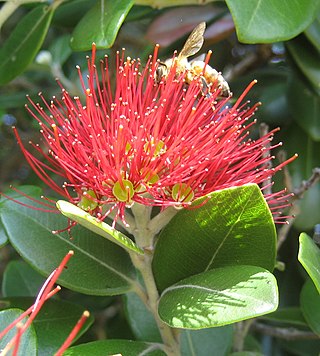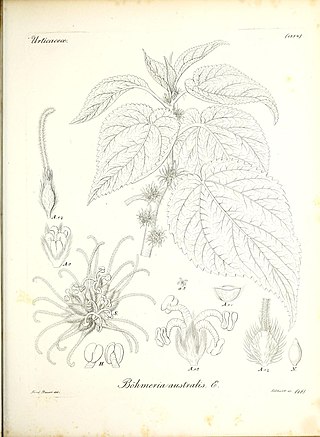
The Kermadec Islands are a subtropical island arc in the South Pacific Ocean 800–1,000 km (500–620 mi) northeast of New Zealand's North Island, and a similar distance southwest of Tonga. The islands are part of New Zealand. They are 33.6 km2 (13.0 sq mi) in total area and uninhabited, except for the permanently staffed Raoul Island Station, the northernmost outpost of New Zealand.

Metrosideros kermadecensis, with common names Kermadec pōhutukawa and New Zealand Christmas bush is an evergreen tree of the myrtle family which is endemic to the volcanic Kermadec Islands about 900 km north-east of New Zealand. The tree produces a brilliant display of red flowers, made up of a mass of stamens and is the dominant forest tree on Raoul Island, growing to 15 m or more. The trunk is up to 1 m or more in diameter. It is very similar to, and often confused with, the pōhutukawa of mainland New Zealand, differing mainly by having smaller, more oval leaves, and by flowering throughout the year. It also resembles the ʻōhiʻa lehua of Hawaii.

The Kermadec petrel is a species of gadfly petrel in the family Procellariidae. It is 38 cm long with a wingspan of 100 cm. It is polymorphic, with light, dark and intermediate morphs known. It eats squid, fish and other marine creatures.

Chthoniidae is a family of pseudoscorpions within the superfamily Chthonioidea. The family contains more than 600 species in about 30 genera. Fossil species are known from Baltic, Dominican, and Burmese amber. Chthoniidae now includes the former families Tridenchthoniidae, and Lechytiidae which has been demoted to subfamilies.

Myrsine is a genus of flowering plants in the family Primulaceae. It was formerly placed in the family Myrsinaceae before this was merged into the Primulaceae. It is found nearly worldwide, primarily in tropical and subtropical areas. It contains over 280 species, including several notable radiations, such as the matipo of New Zealand and the kōlea of Hawaiʻi. In the United States, members of this genus are known as colicwood. Some species, especially M. africana, are grown as ornamental shrubs.

Pouzolzia australis, synonyms including Boehmeria australis and Boehmeria calophleba, is a species of large shrub or small tree in the plant family Urticaceae. It is endemic to small islands belonging to Australia and New Zealand – Norfolk Island, Lord Howe Island, and the Kermadec Islands. The population on Norfolk island, sometimes treated as a distinct subspecies, is critically endangered. In the Kermadec Islands, it was described in 2018 as "threatened – nationally endangered".

Myrsine kermadecensis, commonly known as the Kermadec matipo, Kermadec myrsine, or the Kermadec mapou, is a species of flowering plant in the family Primulaceae, endemic to the Kermadec Islands of New Zealand. It was named by Thomas Cheeseman in 1888, and first described in 1892.
Tyrannochthonius cavicola is a species of pseudoscorpion in the Chthoniidae family. It is endemic to Australia. It was described in 1967 by Austrian arachnologist Max Beier.
Tyrannochthonius queenslandicus is a species of pseudoscorpion in the Chthoniidae family. It is endemic to Australia. It was described in 1969 by Austrian arachnologist Max Beier.
Tyrannochthonius cavernicola is a species of pseudoscorpion in the Chthoniidae family. It is endemic to Australia. It was described in 1976 by Austrian arachnologist Max Beier.
Tyrannochthonius norfolkensis is a species of pseudoscorpion in the Chthoniidae family. It was described in 1976 by Austrian arachnologist Max Beier.
Sathrochthonius insulanus is a species of pseudoscorpion in the Chthoniidae family. It is endemic to Australia. It was described in 1976 by Austrian arachnologist Max Beier.
Sathrochthonius maoricus is a species of pseudoscorpion in the Chthoniidae family. It is endemic to New Zealand. It was described in 1976 by Austrian arachnologist Max Beier.
Apatochernes posticus is a species of pseudoscorpion in the Chernetidae family. It is endemic to Australia. It was described in 1976 by Austrian arachnologist Max Beier.
Haplochernes norfolkensis is a species of pseudoscorpion in the Chernetidae family. It is endemic to Australia. It was described in 1976 by Austrian arachnologist Max Beier. The specific epithet norfolkensis refers to its native range.
Satrapanus is a monotypic genus of pseudoscorpions in the Chernetidae family. It is endemic to Australia's Lord Howe Island in the Tasman Sea. It was described in 2007 by Australian arachnologists Mark Harvey and Erich Volschenk. The generic epithet comes from the Latin satrapa with reference to the pseudoscorpion being the only known species of the genus on the island.
Xenolpium pacificum is a species of pseudoscorpion in the Olpiidae family. It was originally described in 1907 by Danish arachnologist Carl Johannes With, and subsequently remarked on by Austrian arachnologist Max Beier. The species occurs in New Zealand as well as on Australia's Lord Howe and Norfolk Islands. There are two subspecies.
Anaulacodithella plurisetosa is a species of pseudoscorpion in the Chthoniidae family. It is endemic to Australia. It was described in 1976 by Austrian arachnologist Max Beier.
Apatochernes turbotti is a species of pseudoscorpion in the family Chernetidae. The species was first described by Max Beier in 1969, and is endemic to New Zealand.




